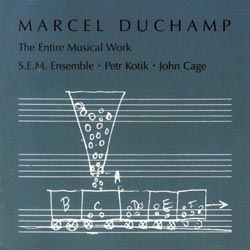
Perhaps coming as something of a surprise to many-though it shoudn't � Marcel Duchamp created three musical works, all early in his career, from about 1912-15. Given the rest of his art, what should be entirely unsurprising is that they anticipate several directions to be taken much later in the century.
The recording at hand, by Petr Kotik and the SEM Ensemble dating from 1987, renders all three, in two cases providing very different approaches, much as one might look at or through the physical actuality of "The Bride Stripped Bare by Her Bachelors Even" and derive an altogether different experience.
"Erratum Musical", for three voices (Jean Crossman, Lois Hunter and William Lyon Lee) divides dictionary definitions of imprimer ("to make an imprint") into 25 syllables then randomly assigns one of 25 different notes to each syllable, the phonemes recited clearly and regularly, in calm fashion, stress determined by the singer. It resembles any number of "avant" vocal works-from the 50s and 60s.
The first version of "Sculpture Musicale" aptly casts John Cage in a prominent role as it was Cage to whom Duchamp gave the "score" in the late 60s. It reads, in toto (translated from the French), "musical sculpture. Sounds lasting and leaving from different places and forming a sounding sculpture that lasts." This gorgeous performance consists simply of Cage, in his inimitable soft voice, reciting the score's words (in French), ordered so as to form a self-referential acrostic when printed which contains words from the score as a vertical spine, over ambient street and automotive sounds. Petr Kotik's variation on the work utilizes a music box which seems to be manually interfered with enough for the first several minutes to render unrecognizable its actual composition, which makes itself known halfway through: "Somewhere My Love". It's very charming, in fact.
The bulk of the disc is comprised of two renditions of "La Mari�e mise � nu par ses c�libataires m�me. Erratum Musical". The first is designed to be performed on a "mechanical piano" and is here realized via a piano roll transcribed by Kotik taking the numbers that appear on the score and assigning note values to them. The resultant music, not dissimilar in character to the other version of "Erratum Musical" on its own, proceeds in an almost stately, if random, fashion, the booming single and dual notes resounding over the constant background thrum of the piano motor.
The second part of Duchamp's score described a mechanism wherein numbered balls tumbled through a funnel into "cars", the sequence and placement of the cars determining the score. Kotik essentially constructed such a device, then transcribed the results for a quintet consisting of himself (alto flute), Bern Neill (trumpet), Rob Bethea (trombone), Gwendolyn Toth (celeste) and Chris Nappi (marimbaphone). Though the tempo is never explicitly spelled out, Kotik begins with the same steady rhythm we've encountered previously before shifting gears to a more sprightly reading and begins to interpolate the initial random outcomes, allowing his intuition some degree of reign. He succeeds in balancing the contemplative with the playful, with some especially lovely sonorities developed. Needless to say, it sounds like nothing else being produced around 1915 or several decades thereafter. Whether or not it remotely resembles what was in Duchamp's considerable brain at the time, who knows? But you wouldn't want to bet against it's being at least one of the considered outcomes.
Comments and Feedback:
|



